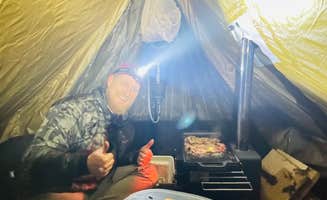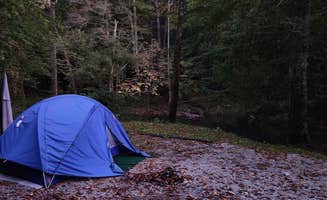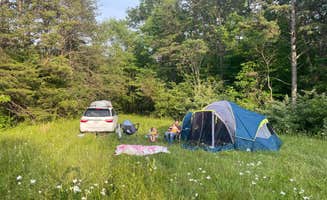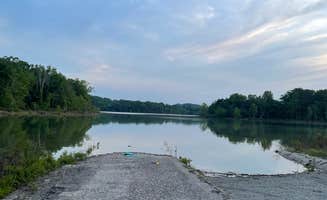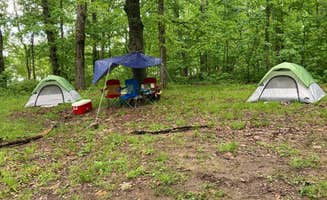Dispersed camping near Pine Knot, Kentucky occurs primarily on U.S. Forest Service land within Daniel Boone National Forest. The region sits at approximately 1,200 feet elevation with creek watersheds cutting through sandstone terrain. Winter camping requires preparation for subfreezing temperatures, while summer brings high humidity and temperatures often exceeding 85°F.
What to do
Fishing access: Rock Creek offers fishing opportunities at Trace Branch Dispersed. According to Matthew H., "We left our site unattended for hours to check out the streams and rivers and nothing was missing." This area provides easy water access for anglers targeting smallmouth bass and various panfish species.
Swimming spots: Natural swimming holes can be found along creek beds near Jellico Creek Rd Dispersed #1. One camper notes, "This first site has room for two groups. It also has a small swimming hole with a rope swing." The swimming areas vary in depth depending on recent rainfall.
Stargazing opportunities: Limited light pollution makes night sky viewing exceptional. Sierra E. mentions at Swain Ridge: "There was no light pollution so we had a great time star gazing! We were even blessed with seeing several bats fly around at night."
What campers like
Creek proximity: Many campers appreciate waterside sites. At Trace Branch, Pam B. reports, "We took our portable firepit and sat by the creek for a beautiful evening." Sites near running water provide both ambiance and practical benefits for filtering water.
Wildlife viewing: The forests around Pine Knot support diverse wildlife. At Bi-Color Campground in nearby Tennessee, Robert W. notes, "Lots of wildlife sounds at night. Also a random herd of cattle strolls through every now and again." Spring and fall typically offer the most active wildlife viewing.
Privacy levels: Most dispersed sites provide separation from other campers. John B. mentions about Bi-Color Campground, "Only saw one other camper on our trip this weekend so it was very peaceful." Sites further from main roads typically offer greater seclusion.
What you should know
Seasonal considerations: Hunting seasons impact campground availability and crowding. Rachel G. warns about Bi-Color Campground: "Rifle season starts Nov 20. I'm 10 days early, and was a bit surprised just how many hunters are already here." Research hunting seasons before planning fall trips.
Campsite restrictions: Not all open areas permit camping despite appearances. At Swain Ridge, Jacob M. cautions, "Not able to camp in open field. $1000 fine for doing so. Camping at trailhead or on road side is fine."
Road conditions: Access roads may present challenges. Michael W. describes, "Dirt road, washboard out was north to Rock Creek campground steep downhill grade narrow. My opinion not for 5th wheel." Most forest roads remain unpaved and deteriorate after rainfall.
Tips for camping with families
Site selection for children: Some sites offer natural features that appeal to children. Nicholas from Bi-Color Campground suggests, "Solid location for a night or a whole weekend... This camp is perfect for the fam as it can accommodate RV sized vehicles."
Pest preparation: Ticks and poison ivy require precautions. Sierra E. from Swain Ridge shares, "We did have ticks EVERYWHERE and poison ivy along the edges of the pasture. We had a ball we were playing with roll in there." Pack tick repellent and teach children to identify poison ivy.
Trash management: Pack out trash as services do not exist. Matthew H. reports at Trace Branch, "Lots of beer bottles left over and shattered so I had to pick up the trash before letting my dog out." Bring extra bags for removing both your waste and potentially cleaning up after others.
Tips from RVers
Space limitations: Most dispersed sites accommodate smaller RVs only. At Redbird Boat Ramp, Kody Bear A. notes, "Plenty of space for a couple RVs. No amenities. About ten miles off 75."
Ground conditions: Be prepared for soft terrain after rain. Nicholas mentions at Bi-Color, "Only word of caution is that the ground can get a bit muddy, so try to find something dry." RVs should avoid setting up in low-lying areas where water may collect during storms.
Water supply planning: No potable water exists at dispersed sites. John B. at Bi-Color advises, "There was no accessible water near by so make sure you bring your own provisions." RVers should arrive with full fresh water tanks and plan for conservation during stays.


